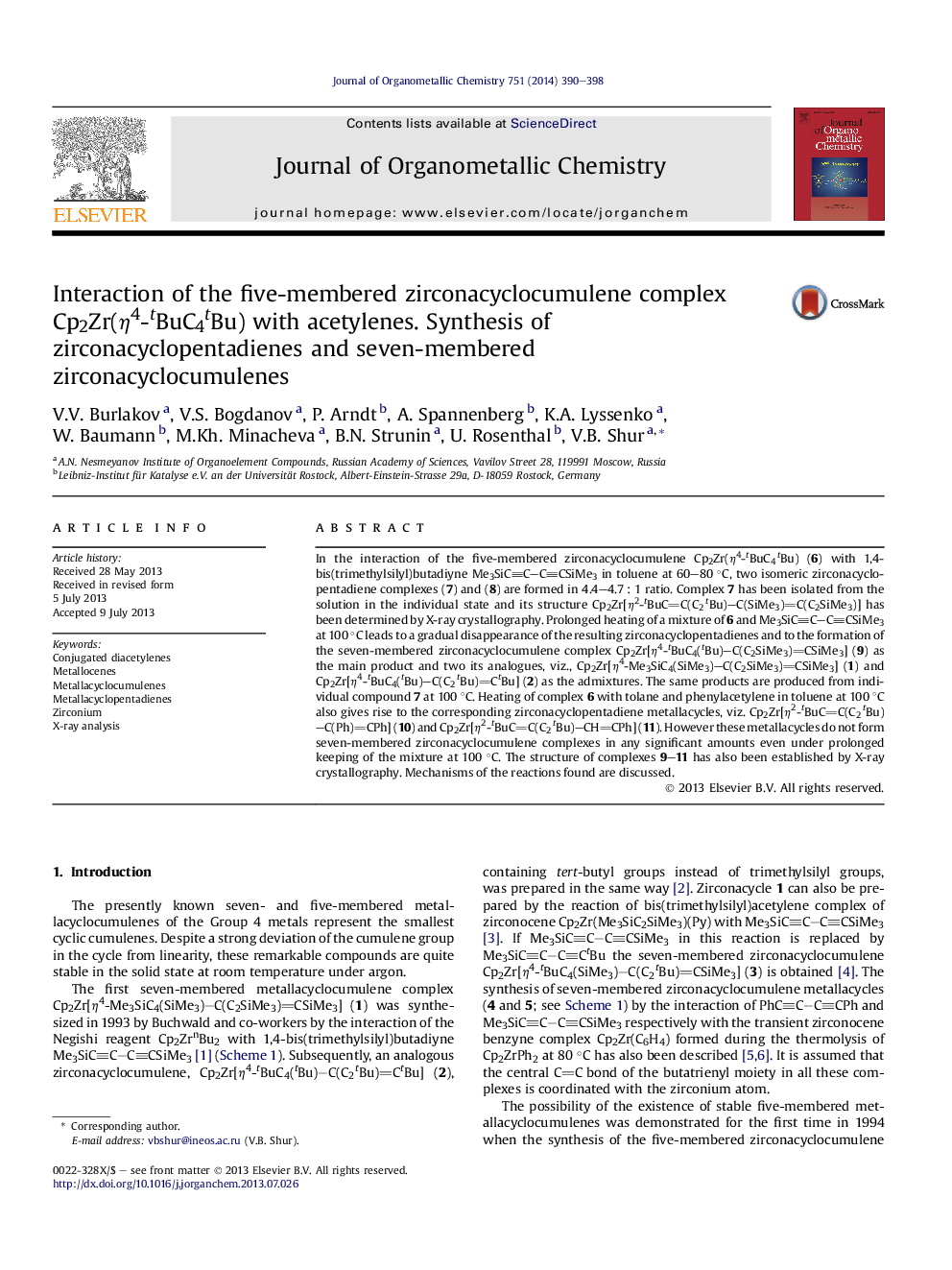| کد مقاله | کد نشریه | سال انتشار | مقاله انگلیسی | نسخه تمام متن |
|---|---|---|---|---|
| 1324292 | 1499889 | 2014 | 9 صفحه PDF | دانلود رایگان |

• The effect of the nature of acetylene on its reactivity toward Cp2Zr(η4-tBuC4tBu).
• Novel route of the synthesis of seven-membered zirconacyclocumulene complexes.
• Formation of zirconacyclopentadienes from Cp2Zr(η4-tBuC4tBu) and acetylenes.
In the interaction of the five-membered zirconacyclocumulene Cp2Zr(η4-tBuC4tBu) (6) with 1,4-bis(trimethylsilyl)butadiyne Me3SiCC–CCSiMe3 in toluene at 60–80 °C, two isomeric zirconacyclopentadiene complexes (7) and (8) are formed in 4.4–4.7 : 1 ratio. Complex 7 has been isolated from the solution in the individual state and its structure Cp2Zr[η2-tBuCC(C2tBu)–C(SiMe3)C(C2SiMe3)] has been determined by X-ray crystallography. Prolonged heating of a mixture of 6 and Me3SiCC–CCSiMe3 at 100 °C leads to a gradual disappearance of the resulting zirconacyclopentadienes and to the formation of the seven-membered zirconacyclocumulene complex Cp2Zr[η4-tBuC4(tBu)–C(C2SiMe3)CSiMe3] (9) as the main product and two its analogues, viz., Cp2Zr[η4-Me3SiC4(SiMe3)–C(C2SiMe3)CSiMe3] (1) and Cp2Zr[η4-tBuC4(tBu)–C(C2tBu)CtBu] (2) as the admixtures. The same products are produced from individual compound 7 at 100 °C. Heating of complex 6 with tolane and phenylacetylene in toluene at 100 °C also gives rise to the corresponding zirconacyclopentadiene metallacycles, viz. Cp2Zr[η2-tBuCC(C2tBu)–C(Ph)CPh] (10) and Cp2Zr[η2-tBuCC(C2tBu)–CHCPh] (11). However these metallacycles do not form seven-membered zirconacyclocumulene complexes in any significant amounts even under prolonged keeping of the mixture at 100 °C. The structure of complexes 9–11 has also been established by X-ray crystallography. Mechanisms of the reactions found are discussed.
The paper describes a remarkable ability of the five-membered zirconacyclocumulene Cp2Zr(η4-tBuC4tBu) (1) to react with conjugated diacetylenes at 100 °C with the formation of seven-membered zirconacyclocumulenes. Monoacetylenes do not form seven-membered zirconacyclocumulenes in the interaction with 1 at 100 °C. In this case, the corresponding zirconacyclopentadienes can be obtained in good yields.Figure optionsDownload as PowerPoint slide
Journal: Journal of Organometallic Chemistry - Volume 751, 1 February 2014, Pages 390–398